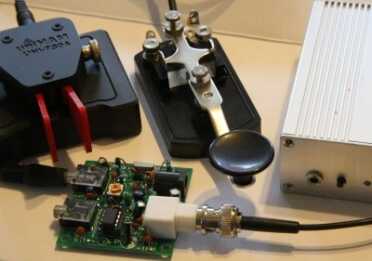
The radio on the right is a completely assembled Rock Mite PIC chip radio. The green board is the Pixie. The red key is the $50 electronic iambic keyer, and the black one is the standard straight key.
Resources:
Pixie QRP Radio – Assembled $12.31
Rock Mite PIC Version – Assembled w/case $37.89
40 Meter Whip Antenna – $23.49 shipped
40 Meter Dipole Antenna – $25.85 shipped
Manual Antenna Tuner DIY Kit $10.99 shipped
Iambic Keyer – Red Paddle $49.99
Iambic Keyer – Te Ne Ke Version
Plastic Straight Key – $19.95 (no cable)
150 Watt Power Amp – $110
About the scariest thing I can think of is to lose contact with my children in a world over the brink of collapse. Most young people don’t even have a land based phone line these days, so if the cell networks go down, that’s it. But there is a way, if you do it now, to establish a communications protocol with loved ones who are hundreds, or even thousands of miles away. As I’ve discussed a few times before in this column, the Amateur radio bands, otherwise known as the Ham bands, under 30 megahertz, are capable of reaching around the entire globe at certain times of the day. Full access Ham radios, covering several bands, or even all the Ham bands, sell for $300 to $10,000, but I found some small radios that cover only one frequency for as little as under $10. You have to still buy an antenna, but the overall cost could be as little as $50. As a bare bones mode of communication on a very tight budget I don’t think you can beat these little radios.
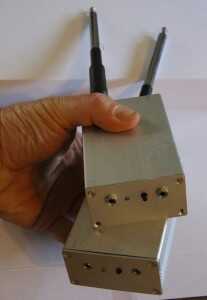
The assembled Rock Mites are the best option if you don’t want to solder and you want a single channel CW (Morse code) that could potentially reach the four corners of the earth.
Since I recently ran a “Worldwide Radio for under $10” article, let me clarify first how this differs. The RTL-SDR radios are USB bugs that only receive. I am in the processing of testing a couple SDRs that do transmit, but they are a totally different technology than the USB bugs and comparatively a lot more expensive for what you get as compared to analog radios with the same amount of coverage. And you do of course have to have the electricity to run at the very least a decent power laptop computer with a good sound card. I had high hopes for SDRs, but so far they have proved to be more complicated and expensive than they are worth.
If you just care about being able to listen to communications from all over the world, an RTL-SDR and a really good antenna are all you really need. These radios in this article both receive and transmit, and from what my research has shown, that is where you get into real money. Radio technology is really old and there are plenty of circuits long past their patent dates, but none of that seems to matter. If you want to transmit, how much money you pay boils down to how many bands do you want to cover and how much power do you want to transmit with. I have found a ton of good $300-$400 Ham radios on Ebay that both receive and transmit on the HF bands, which in Ham language are the 160 meter through 10 meter bands or 1.5mhz – 30 mhz. But cheaper than that you won’t find much.
Low Wattage = High Performance?
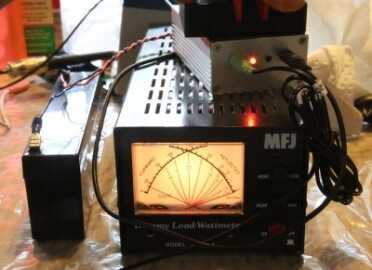
The Rock Mite measured over 5 watts on my dummy load wattmeter. That is enough power on certain nights, with good antennas, in the 7 mhz/40 meter Ham band to reach thousands of miles believe it or not.
There are essentially two parts to any Ham radio. One part is the radio part, which selects the frequency and turns your communications, either voice or electronic pulses (Morse code) into radio waves. The second part is the power amp, which actually sends the radio waves out through your antenna at whatever power you have selected, or that is built into the radio. These radios have very little output in the power section, and they are called “QRP” radios by Hams, because they are under 10 watts. Experienced Hams actually have QRP contests where they limit their wattage to under 10 watts (some say less than 5w) specifically to make long distance contacts with that extra challenge of low power. If the bands are propagating well, and your antenna is set up properly (which I’ll get to), even a radio under one watt can be heard worldwide. That may seem crazy, but people do it every day. I will show you how to up your power on these radios below, but beware that more power means a heavier load, and more power required. These radios alone are a very sound basis on which to rely. You just have to test them first, which means that you either have to get your own Ham license, or ask a couple of Hams to test them for you. After the collapse the license won’t matter, but today it does.
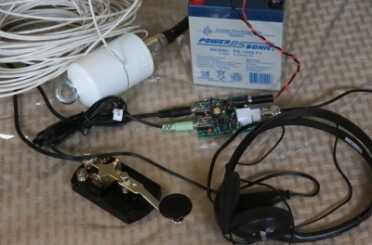
Morse code may seem like an outdated and outmoded technology, but after the collapse, when your only electricity is going to come from wind, solar or hydro power that you own, low power/low amperage radios like this 1 watt Pixie radio are going to be the best game in town. That is a $20 plastic straight key, and the antenna is the 40 meter dipole mentioned in the article. It has two wires 33 feet long, so it needs some space, but it is very sensitive and will handle the power of the booster below.
Is Morse Code Really Outdated?
The answer to that question is surprisingly no. Morse code, or CW, is the most efficient use of a small radio’s power. Encoding and decoding can be done off of your radio time by just writing down the message to send, and writing it down when you receive it.
One of the hardest concepts for me to grasp when I introduced myself to radio technology was the idea of “bandwidth.” A radio signal has a width, and different types of signals have different widths. Modern FM radio signals are huge, like 30,000 hertz wide, because they allow for a huge dynamic range in the music. AM broadcasts are much “thinner,” about 10,000 hertz. But Hams figured out long ago that they could split the AM signal even further, into two “single side bands,” upper side band (USB) and lower side band (LSB), and that this would require half as much power to send a slightly less quality signal just as far. All Ham radios that cover the HF channels will say SSB on them, and they will have a switch for USB, LSB, and CW.
CW is Morse code, and it is very narrow, as narrow as 150 hertz. That makes for a very efficient broadcast at low power, because all of the radio’s power is directed to a very thin signal traveling as far as possible. These radios broadcast and receive only Morse code at 7.023 mhz. They use the most simple circuits possible, and they run on 12 volts, which can be directly from your car battery with your engine off. You will need a specific antenna for the “40 meter” Ham band, but they can be had for fairly cheap. The radios themselves are as little as $5.
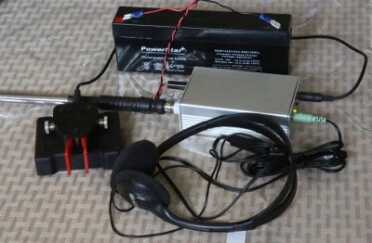
Of all the cheap CW QRP radios on Ebay, the best buy is the Rock Mite in this assembled kit. If you are a hobby solder expert, by all means get the 10 watt radios if you want, but for expedience this is a great radio. This is the red Iambic keyer with it. The Rock Mite recognizes the stereo cable so you can send dits from the left and dahs from the right. There are also programmable auto-codes built into the PIC programming.
Pixie vs. Rock Mite vs. 49er vs. Frog Sounds
If you search Ebay for “qrp transceiver,” you’ll see a ton of different kits come up. Most of them require soldering, and unless you are experienced with a soldering iron I would not suggest you experiment with these. I have built guitar pedals and amps for years and I still find myself making bad solder joints, bridging connections and lifting pads with too much heat. I did buy some of these kits and they are waiting for me to break out my soldering kit, but for now, you are better off to get the finished versions.
My preference is the assembled version of the 4 watt Rock Mite that has a PIC logic circuit built onto it for electronic keying. This allows you to use what is called an iambic paddle keyer. I found that it automatically recognizes the $50 paddle keyers on Ebay, and the left paddle sends a dit/dot and the right paddle sends a dah/dash. This one also is mounted in an aluminum case, which almost none of the other cheap QRP CW radios have, even the assembled versions. For this article I tried the $38 version, and I also bought the $50 version of this radio for an upcoming article on using your computer to send and receive radio messages. It has a com port. Both of these radios will send automatic CQ CQ CQ messages, and can be programmed to even send your call sign, but the translated Chinese directions are really cryptic and will take some experimentation.
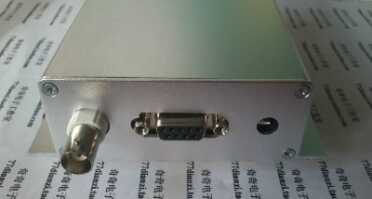
I am not getting into connecting a computer to one of these radios for this article, but there is a step up Super Rock Mite that is only slightly more assembled, and it comes with a COM port connector.
I didn’t focus on the computer connected radios at this point due to both portability and power. My choices here are “bag radios.” With the battery and headphones, they’ll fit in a 1 gallon zip lock bag, and without the battery, hooking it to abandoned car batteries as you travel, the overhead is less than a pound, including a good antenna! You can and should use the links I’m giving you to do your own research into what type of radio suits your needs. I picked two no brainers here to test, but since I don’t have my Ham license yet, I can’t even really demonstrate how to use them. I don’t think the FCC is going to come knocking on your door if you send a Morse code CQ CQ CQ from your little Rock Mite once in a while to see if your daughter 500 miles away can pick you up, but I’m not going to tell you to go break the law. What I can say is be considerate. I hooked up one of my regular radios to listen to see if these radios even worked, and occasionally I would get actual Ham transmissions at this 7.023 frequency. Licensed or not, be courteous, and do your homework as to how Hams operate as per my prior articles.
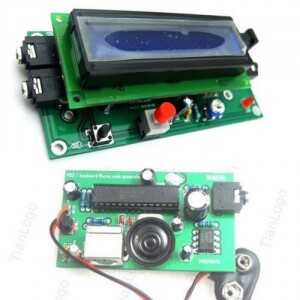
This is the Morse code write and decode set that is on Ebay for under $40. The bottom board connects to a PS2 style keyboard and turns keystrokes into audible Morse code. The decoder takes audio input and turns it into characters on the screen. It can also take input from a keyer, for practice.
The other radio I successfully set up is the assembled version of the Pixie. It sends just over a watt at 12 volts but will run at slightly less power on a regular 9v battery. The kit version of this radio goes for as little as $5 on Ebay, and there is one guy selling assembled kits for $12.31 shipped. I bought two and they arrived in a few days from China, nicely soldered. For some reason there was an extra 1/2 watt resistor in the bag, and I haven’t gotten an answer as to why, but the radio seems to work as is. It didn’t register on my wattmeter, so it is truly low power, but it is the radio part of the radio and it does transmit a strong clean signal.
There is no case on this Pixie radio, and the jacks are right on the board. I had to use a small screwdriver on the trimmer pot to get the radio to not squeal, but once it warmed up and settled in, the frequency stayed rock solid with no real noise. It does not have an electronic keyer so only the dit side of my paddle keyer works, and a regular straight key works fine as well.
There are also radios on Ebay ranging from 1 watt to 10 watts with names like “Frog Sounds,” “Forty-9er,” and a Russian option called “Bitx.” In the last couple weeks a new model has appeared from Greece that looks really robust called Radi0kit, but like the others, these are DIY solder at home kits. All of these circuits are based on time tested designs that were popular among radio amateurs in decades past. It was “a thing” to build a QRP radio into an Altoids mints tin, and as you can see from the photos, I actually bought an old Altoids radio on Ebay to see what it had inside. It was a Pixie board, but unlike these Pixie boards that we can buy today, it didn’t have the jacks built into the board.
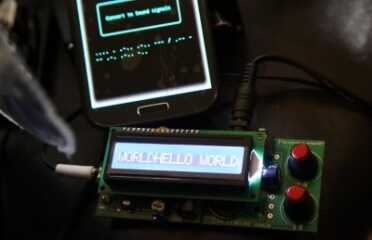
Turning text into audible tons is easiest done on your phone with one of several CW encoding programs. With some adjustment I got the decoder to successfully decode when sent directly from the phone headphone jack, at 20wpm.
I don’t have anyone hundreds of miles away willing to test these radios with me, but I can tell you that I hooked up both of them to my dummy load and wattmeter and the Rockmite showed 3-4 watts. The Pixie is broadcasting, but it didn’t budge the meter, which in fairness isn’t built for testing QRP radios. A dummy load is the best way to test radios without a license, because it doesn’t actually broadcast to an antenna.
Antennas
Far more important than which radio you pick is buying a matching antenna. Ham antennas are a more complicated technology than you could ever imagine. But if you think about it, why wouldn’t it be complex? We are talking about propagating radio waves across the planet using layers of the ionosphere. Then receiving tiny microvolts of signal and converting those into sounds. We lose our cell signals when we move out of line of sight of a cell tower. Ham radio is a miraculous technology that never needed to mature because it is so good.
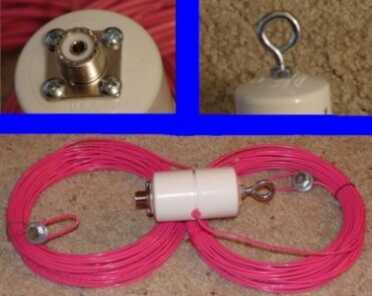
For these radios you will want to buy a 40 meter dipole antenna. If you plan to run a length of connection wire, you should also buy a 1:1 balun to put right before the antenna. This concentrates all of your send power into the antenna instead of wasting it in the connection line.
For these radios you are looking for a “40 meter” antenna, and I found two inexpensive options that both work to varying degrees. For the money, I would get both.
The first is a 40 meter whip antenna at $23.49 shipped. In the add they show the antenna hooked up to the same antenna analyzer that I have and it shows an SWR of 1.2:1, which in Ham language equals pretty darn good. This whip will be much more effective if you hook a long wire to the negative pole on the antenna connection and just lay it on the ground. It is called a counterpoise.
The alternative is an antenna tuner, but I have yet to find a completed kit that is really inexpensive. Most antenna tuners start at about $70 and go up from there, but you can sometimes score small wattage tuners on Ebay for cheap. The DIY kit for a manual antenna tuner up to 15 watts is only about $11 on Ebay, but you have to build it. I ordered a couple but haven’t soldered them because alas, I already have a QRP antenna tuner. I actually got in included with the Altoids radio for $40 total. A manual antenna tuner is pretty easy to use if you experiment with it. You just listen for maximum static on your band.

The whip antennas may be all you need if you plan to use these radios as 100 mile walkie talkies. For longer distances you’ll want to add a counterpoise or an antenna tuner.
A more robust antenna specifically for these radios is a 1/2 wave dipole. I ordered one from Ebay for $25.85 shipped. The only think about this guy that I can’t figure out is whether his antenna has what is called a 1:1 balun as part of his middle connector. I tried to take apart the PVC apparatus but he intentionally made it a “black box” that you can’t get apart without cutting. At his price you really can’t even buy the components for cheaper. I assume it doesn’t have the balun. Regardless, it is a good buy.
A balun is an interesting device. If you are going to put your radio right next to your antenna, with a very short connecting line, you don’t really need one. A balun isolates your antenna from your feed line so that your feed line doesn’t itself transmit and suck radio frequency power away from your antenna. If you plan to run a long cable from your radio to your antenna, regardless of what radio and what antenna you use, it is a good idea to include a balun right before the antenna.
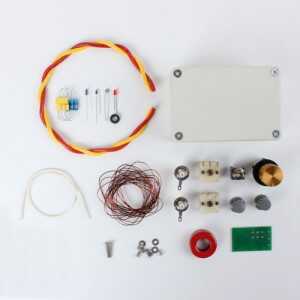
Occasionally I find cheap manual antenna tuners on Ebay, but this kit is all that is out there right now. If you solder, it’s not a huge project for about ten bucks, less than you could buy the components for at Mouser.
Your other option for QRP communications is a “random wire” antenna. It is just a wire, connected to the positive antenna out on the radio. You can Google random wire or longwire on the internet and find the suggested lengths. For 40 meters, in the 7mz range, the best results seem to be about 52 1/2 feet. You should also use an RF choke on the line, as per the diagram I am including here. For a random wire, or end fed dipole, you need a 9:1 balun. They are available on Ebay for as little as 10 bucks, and if you want more wattage, you can find them for $30 or so.
I should also mention connection wire. There are a few types that come with the connectors used for Ham radio. If you can, get LMR-400 or equivalent. It is very stuff with thick wire inside. Compared to RG-8 or RG-58 coax the performance over long runs is much much better. On a low wattage radio you want as little resistance in your cable as possible, and thick heavy cable is important even on powerful rigs. If you aren’t going to be mobile, it is worth the investment. Note also that you are going to need a BNC to PL-259 adapter. I don’t know why they insist on using a half a dozen different connectors for Ham radios, but these two are the most common.
Automating Morse Code
Notice that I didn’t title this “Learning Morse Code.” Because like learning any language, learning and using Morse is all about practice, and regular use. Maybe you have time to “chew the rag” with other hams using Morse code, but I for sure do not. That is why I immediately went looking for ways to both send and receive Morse, or CW (continuous wave) transmissions automatically. So far I have had very little success, because one specific technical detail about these radios.
A real Morse code signal is not generated by a sound. The “keyer” port on any Ham radio is an open voltage circuit, and when you close the circuit, the radio generates a tone. A standard “straight key” is nothing more than two contacts with a spring and a button to make the job of sending Morse code easier. Modern radios, including the Rock Mite, can process signals from a stereo cable and send both dits and dahs, but the basic premise of a “key” is the same.
The electronic Morse code sending circuit boards on Ebay send audio. They do not switch a current on and off. This is also true of all the Morse code smartphone apps. They are great for practicing Morse, or for sending it audibly over an SSB connection, but as a regular keyer they do not work. I bought a keyer/reader combo package on Ebay for $34, and it is mostly useless, for now. I just found a circuit that supposedly converts audio signal to on/off open/close connections and I’m hoping to bread board it for a future article.
The only thing I have found that will actually send the Morse pulses is the MFJ-452, as you’ll see in the pictures. At first it was a bust, didn’t work. But after a call to MFJ support they figured out that the jumper inside was set wrong. When I reset the jumper it worked! As for the Morse generators from China and the phone apps, if you want to join me in my quest for making an automted Morse code sending application, you can check out the Github project for yourself. I found the transformer at packetradio.com, and the rest of the parts I either had or ordered from Mouser.

For 40 meters you can see the different SWR ratios for the different lengths. A 1:1 is the goal. A wire of 52.5 feet is good for this balun, but it can’t handle high wattage if you add a linear amplifier.
Morse readers come in a few different flavors. The one that I found works the best is $27 and has two potentiometers on the side, and you adjust the sensitivity with a small screwdriver. If you can get the light really bright it will decode the messages from the phone apps via a direct cord connection, not that this is of any use. Morse is notoriously hard to decode over the airwaves, though it is technically possible. My Android phone app decoder was completely useless, even with no noise floor or interference. It was actually a farce.
Keep in mind that these radios are really inexpensive in the world of Ham transceivers. Real radios with lots of band options and filters are expensive. There are still Yaesu FT-101 tube radios from the 70s going for over $300 on Ebay, and sometimes as much as $700. I have an article coming at some point on HF transceivers, but if you want to see what your options are as compared to the QRP radios, you can search Ebay for (Icom, Yaesu, Kenwood) hf tranceiver. Once you go into one of the radios that are bidding in the $150 – $300 range, you’ll see the “other items” that will lead you to more of the same. There are plenty of old Ham estate radios that work great out there, but be careful to read the descriptions, because many of the cheapies are problem radios that experienced Hams have gotten at swaps and that they just want to get rid of.
For this kind of money, you are getting a lot of radio, and they do actually work. If you want something even a little better and more flexible, you’ll pay a lot more, and you will almost definitely have to solder. I have seen a few YouKits built receivers in the $150 range, but you have to look for them, and they will only have a few bands for CW. If you want a radio capable of SSB, for voice, plan to pay over $250.
Boosting the Watts
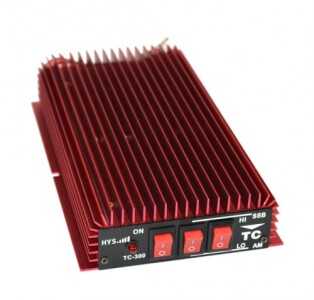
This 150 watt linear amplifier is just over $100s, and runs on the same 13.4 volts that power your radios.
The nice thing about QRP radios I think is that you get what you pay for. All radios receive the same stuff, so as long as you are careful with a good antenna, you have as good a chance at hearing things as any other radio. There are input filters and RF boosters built into full radios for the receive signal, but to a large degree, incremental cost on radios is added by the power to transmit more power at a more tailored signal.
You can, as I said, talk worldwide with only a few watts of power. The bands have to be very favorable, and both parties have to run good antennas, but it is possible. Hundreds of miles is an everyday thing, especially at night on the 7 mhz band. For survival on limited resources, QRP radios only draw in the milliwatts of power, whereas a full featured Ham radio, even a mobile one, will draw 10 amps minimum, which is 120 watts. On a small 5 amp/hour battery, drawing the battery down to half is only going to give you 20 minutes or so with a full sized 100 watt radio. A car battery might give you an hour or two depending on the age of the battery.
If you want to boost your HF Ham signal, you can use a straight linear power amplifier. I found a couple of them that are reasonable, and this one is generally just over $100 shipped. It claims to send 150 watts, but I have yet to hook it up to my wattmeter from the QRP radios. I also bought some circuit board linear amplifier kits, but I haven’t found any that are worth considering for a non-hobby/survival budget. The ones from Russia are cryptic at best, and they require a huge heat sink. This red one seems like a safe bet.
Powering Your Rig
My intention with this project was to create a bag radio that you can give to loved ones, so that when the time comes, they can follow a simple set of directions to at least have a chance of making contact after the normal modes of communication go down. To do that you need to have a power source for your rig that fits in a bag, and that won’t need to be recharged for hours of occasional use. My suggestion is to use 12 volt (actually 13.4-8v) sealed lead acid batteries that are meant for golf carts and kids scooters. They come in a number of sizes, from about 2 amp/hours to 10 amp/hours, with proportional size and weight. The grey ones you see here are $26 for 2, and they are 5 amp/hours each. The long black ones are 2.3 amp/hours and $12.50 each. The large 10AH batteries are $25.25 for 2.
All of these batteries come with ears for clip connectors, and they are the same connectors you can get at Walmart in a kit with a crimper for about $5. I just take a regular 5.5×2.1 jack connector and crimp the clips right onto the wires. It would probably be smart to put an inline fuse, but I never have and though I do see sparks occasionally when I plug them in, I haven’t fried anything yet. The receive current on these radios is only about 10ma and even transmit is in the 100s of milliamp range, so a one amp fuse would be overkill.
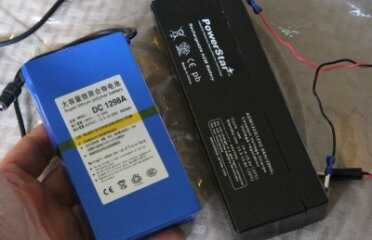
These polymer li-ion batteries look great, but they are only about 1ah and in my experience fail too easily.
What I don’t suggest, and I wish I didn’t spend my money on, are polymer lithium ion battery packs. They look great, because they have on/off switches, and they come with a wall wart charger and both male and female charging connectors wired right in. I knew that these batteries tend to get hot on discharge and even while charging, so they are a fire hazard, but I didn’t realize that they also fail really easy. One of the two I tested failed on me with a simple thing of connecting a device while charging. If their are warnings about this they are in Chinese, so I had no idea. The polymer batteries are really expensive, like $30 for about 1 am/hour, so even though they will power one of these radios for a long time, I wouldn’t consider them.

This is a screen shot of DX Atlas. The overlay is the F2 layer of the ionosphere, and it shows where you might be able to reach if you are in a certain spot. From South Florida, on this map, I could possibly reach into Morocco and the Western provinces of Canada right now. Download DX Atlas and you’ll get maps like these for free.
Finding the Bands
I hate to say this, but when it comes to worldwide communications on the HF bands, the radio is the easy part. Learning about antennas, filtering and band propagation is hard, and even if you never get your license, you do have to learn some of it if you ever want to be successful. I personally have not had the time to properly learn all of the very basics, even though I have been able to put up a real 80 foot multi-band dipole and get some contacts logged. Electronics in general is a field of study that never ends, and radio waves and radios are just a subset of that. I’ve been building guitar amps for 20 years and a lot of the electronics involved in radios were not new to me, but I have learned a ton in a very short time, enough to figure out how much I don’t know lol.
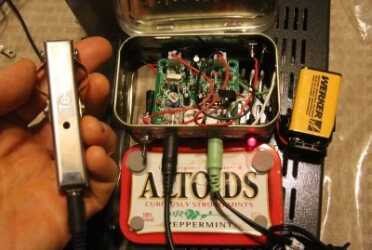
The classic QRP radio in the Ham world is built into an Altoids tin. Out of curiosity I bought this one on Ebay because it came with a mini antenna tuner, and inside I found the “other” Pixie board on Ebay, the one that doesn’t have the 5.5mm jack installed in it. This guy taped together two Altoids tins so he’d have room for the battery, and for some reason put an RCA plug for the antenna. But it works! The keyer in my hand is the Te-Ne-Ke portable iambic keyer linked above. This Pixie doesn’t support the stereo cord dit/dah either.
The HF bands ride on the F2 layer of the ionosphere, and I found a nifty program that helps you visualize the areas that you can connect to at any given minute of the day, by plotting the patterns that the layers favor around the globe. Download DX Atlas and you’ll get maps like the one you see on the right here. You’ll also see the license prefix for all the regions of the globe, so if someone is calling CQ from a VK prefix, you’ll know that it’s Australia. Cool stuff, and it should get you on your way to a lot of other free programs and a lot of free knowledge as of today is still out there. Once the music stops this will all be gone, so be a wise person and take advantage of it today. Ten years early is better than one day late.

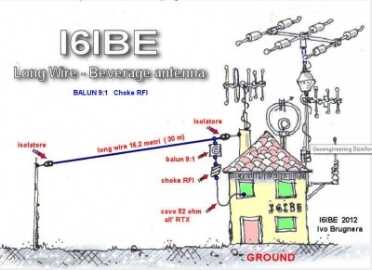
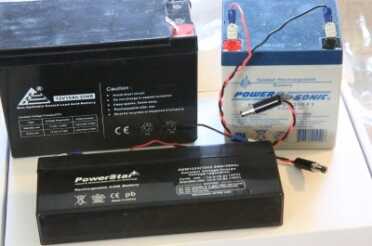
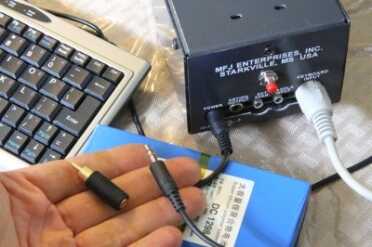
I have followed your web site for several months and in response purchased a RAYO lantern.
When it comes to Ham Radio, I just finished taking the Technician test. I am 75 years old and passed with a 34 out of 35 score. If it is important enough for you to obtain communication by using this civilian not government regulated radio system then do it honestly. If I can pass the test you or your readers can pass the test. The world is in the mess we are in because a huge number of people feel it is OK for them to break the law weather its crossing the border, not buying car insurance or not applying for and obtaining a Ham radio license. You as a highly viable firearm sales organization have a responsibility to the american public to set a higher example of honesty If as you are suggesting to your followers it is all right to cheat those of us that are honest by saying it’s acceptable to break the law I am through following your column.
Jeez, every grouchy old HAM radio geriatric within the lower 48 must have hopped on here to dispense their wisdom and deride the original post. Tone it down guys, the post is informative, useful, interesting, and actually shows those of us who might not have dedicated our life to communications in grid down situations a thing or too about old tech that is still relevant and useful.
Thank you to the author for the original post and the great information. I’m sorry you had to take time out of your day for all the moronic critics.
OK. Where to begin. OK. Can you hunt an elephant with a .22 rimfire? Why yes, you could… in theory. Would you hunt elephant with a .22 on your first hunt? I mean first hunt ever? No, you would probably leave that kind of crazy hunting to the expert, seasoned hunter, right? Well, that’s a little like QRP (low power, less than 5 watt) radioing. First you need to have good operating skills, sort of like good marksmanship. If you can’t send and receive solid copy at 20 words per minute, you won’t be much good at QRP operating. And those code copy machines don’t work well with the weak QRP received signals. Then you need good knowledge of how the bands work. That only comes with a great deal of experience. Then you need patience. You won’t make contacts every time you want to. Sometimes the band conditions just won’t allow it. I could go on. QRP is cool. It’s fun. But it is like fishing for Marlin with a 6 pound test line. And finally, as much as I enjoy it, I’ll be frank, QRP is just kind of a novelty. The very idea of working someone in Europe from continental U.S. on 2 watts! The reason I bring all this up is I believe you may be building unreasonable expectations of what a QRP HF rig can do. You cannot This might be setting people up for failure and discouraging them from getting into HAM radio.
“The whip antennas may be all you need if you plan to use these radios as 100 mile walkie talkies. For longer distances you’ll want to add a counterpoise or an antenna tuner”. This statement is just wrong. 40 meters doesn’t work that way. I’m trying to be diplomatic, but… you’re not a HAM are you?
One can purchase almost any good, used, very serviceable, all frequency, ham radio from a “Ham Radio Convention” in the parking lot or at the flea market for usually under $50.00.
20 to 30 year old “used” transceivers will cover most bands used by hams today, with power in the 100 to 200 watt range, which is more than enough power to talk coast to coast under ideal conditions. The price of some radios will occasionally be in the $25.00 to $40.00 range and peripheral equipment such as keys, mikes, antennas, antenna tuners and power supplies can be bought for similar savings.
One should be able to buy a complete used ham radio system for under $100.00 which would probably have cost in the neighborhood of $500 to $600 new.
KB8TG
Yea that’s broken lol. Those radios change hands a dozen times until someone with a conscience throws it away.
Is Morse Code dead? Does he US NAVY use it ? I’ve studied it and have it on hand .Good article,a little hard to digest,so I am going to read it over.Thanks
***
HI ADMIN–how do you think that the cw Morse Code systems described above will provide reliable communication beyond line of sight / ground wave distances? The various intermittent ionization layers (skip) are the only way to get HF beyond these distances. Repeaters, satellites, high power moon bounce, or very low frequency (30 Khz. Navy submarine commo megawatt transmitter) systems are the only reliable way around Radio 101 limits. There are tons of books out there that go through the signal strength / reception distance calculations.
***
I designed and built CB and other radio systems as a teenager. Then got my BSEE and MSEE degrees decades ago. I worked in the radar and telemetry areas for 41 years at White Sands Missile Range for 41 years with a defense contractor. After 2 years as an Army Draftee. I know beaucoup about wave propagation and radios!
***
If a 50 Kw. AM station has a daytime range of a few hundred miles–and possibly 300 miles at night when solar and other noise levels are lower–why do you think that far higher shortwave frequency radios with a watt or less can provide reliable communication?
***
John Bibb
***
What? The F2 layer of the ionosphere propagates HF signals all over the planet? Maybe you’re on another planet where people talk in extinct programming languages?
Paul, alias Admin,
You rant against people giving bad advice, yet you poke fun at people with a great deal more understanding and education about radios, and you pour out poor to awful advice regularly. One big question is why do you post so much extremely poor advice as factual?
You show a general lack of understanding of what happens when a society collapses, history is filled with examples, all extremely bad!
You make fun of sound comments, my guess because you do not understand just how stupid you come across frequently, or maybe you do and think by tearing a page out of the liberal’s book you can make yourself look better.
I do not know, nor do I care, but you seriously need to gain a better understanding of what you propose before putting it out as factual. A good example is your recent article about long term food storage. A few good points followed by a few horrible points, does not make you knowledgeable on the subject.
Pay attention to those whom are willing to comment with much more knowledge and training in areas you keep claiming to be helpful in! Don’t be so sensitive to help you perceive as being critical. When in fact it is often good information you have overlooked.
What isn’t factual? CB radios for survival are a factual benefit? I just now happened to be testing radios for an upcoming article when I sat down to check comments. I got contacts in the middle of the afternoon on 40 meters with $300 radios from Arizona, Massachusetts, Missouri, Texas, New York, and Germany. How do CB radios fit there? They can’t even use repeaters?
And talking about the liberal playbook, what are the factual errors in any of my articles, including food? Good comments, like the guy on that article who said that canned beefaroni doesn’t taste good after more than two years, do make it through and usually have a thankyou attached. Fools like you take something you disagree with, like CB radios for survival, and repeat that anecdotal case as factual, and proof of poor research, when you are incorrect about it to begin with. Fools generally haven’t actually done anything either. I just tested 6 radios that I paid for and took video of making contacts.
The author lost me at “I don’t have my Ham license yet.” And he advocates sending out CQ’s to test out the radio, without a license. That’s pretty sad to those of us who have been licensed for many years. Theory is great, but getting your license and practically applying the license knowledge is better. Yup, you can use any radio, any frequency in an emergency, but it’ll be interesting to see how many can actually successfully transmit without “hands on” experience. Stop writing articles and get your damned license, there’s no excuse not to pass the watered down exam they now give.
I enjoyed the hell out of this being 70 yrs old on my first license and being rather dumb as a ham and a PC idiot, first time to understand side band explanation somewhat better. Thanks.
***
Why not just buy a small cheap 12vdc. CB radio at a truckstop? They cost around $40 bucks, have a 4 watt output, and do AM voice. There are also cheap handheld walkie-talkies for them. A 7 ft. vertical wire on a wooden dowel insulator and a ground is usually good enough for a few miles. Making a horizontal dipole is also easier–and polarizes the signal properly for skywave propagation.
***
No license required if used as described in the instructions. Using any radio for long range type communication requires a license and different (ham band) frequencies.
***
Rocketman
***
Because *** cb *** radios *** only *** travel *** line *** of *** sight *** and *** if you bothered *** to read *** the other *** articles here *** you would know *** that HF *** is the only *** answer *** why am I typing with asterisks *** what am I *** an idiot? ******
CB IS HF! There are CB’s that communicate worldwide on the 11 MHz band regularly. They also “overrun” the 10 and 12 MHz (by accident of course). They are firing up their Amp to 500-1500 watts or higher (illegal) but remember during an emergency event the FCC lets anyone to contact anyway and anyhow your can. Licenses are out if it is a true emergency. Why don’t you get a ham license and grow up?? Morse code is not dead and it will go anywhere when nothing else will.
***
HI JW–It’s 11 meters for CB’s basic wavelength. About 27 Mhz. frequency. 40 AM channels 10 Khz. spacing. I’ve heard skip signals from 800 miles away at times, and from 2000 miles away other times. Very clear–but didn’t last more than 5 or 10 minutes. Not very dependable! From a moving car about 10 mile range.
***
The 3 asterisks I use are the old Fortran programming trick to try to separate various comment thoughts. And to begin and end subroutines or program segments.
***
John Bibb
***
Hearing skip signals isn’t communicating. Why do people have to cling to bad advice?
Hello,
Here is a program that works with the computer.It’s a freeware called CwTYPE.
Good luck.
There are a number of programs that work with computers through COM ports and sound cards, but that requires a computer, as explained in the article. We will address that subject, as well as PSK-31, RTTY etc., in a future installment.
When the SHTF as they say, license or no will not make a difference, as no one will care. I have been in Ham Radio for over 23 years and helped in various emergencies, and have never heard of a citation nor warning for using HF in case3 of an emergency without a license. The same goes for using a police or emergency radio , and not being licensed. If the need arises, do what is needed and worry later. I very much enjoyed Your article, and found it very informative. Keep up the good work W5ROY Extra Class
As a Ham of 20 years the first 2 things I shall reach for in the SHTF situation will be the 1911 and the 870.
The problem here is that maybe propagation will not be to ones advantage at transmit time and another factor being when broadcasting especially locally you may be tracked and some unexpected folks show up. Better I think to monitor the airwaves in most cases.
Guys if the SHTF who is going to worry about licenses? Survival is the key.
A little sarcasm here James, don’t take it personal…but do you practice your shooting now for SHTF? Bet you won’t be practicing when it happens; same here with radio, practice now, legally, to be proficient when needed.
It doesn’t take much to get a license today. I used hamtestonline.com and got my Tech and General in one day; took me a little longer to get Extra. My impetus was prepping, so I have assembled equipment useful during emergencies and disasters, however my expectation is to use it more for information gathering not for locating help.
BTW, I received my license when I was 66, now 70.
Tony, just a bit of fun. Having been a communicator in the Marine Corps for over 20 years I am prepared. And I do practice my shooting as well. Have a good one.
The F.C.C. is very clear on this: In an emergency, we have the right (and responsibility if it applies) to use any radio, on any frequency, to address that emergency, no license needed.
Just make sure it is an emergency! Wanting to know where the next road side rest area is, is not considered an emergency. Seeing a law enforcement officer, on the ground, in distress, IS. Common sense is dictated.
MC~Using a ham radio without a license in an emergency is not to be used unless the following conditions exist;
1) The licensee is having a heart attack
2) There is no 911 coverage On the cell phone
3) You promise to get a ham license, after the emergency is over.
Do you know which Frequency to transmit on ?
Usually, there are different repeater freqs. in each area.
Learn ham radio, study and get licensed -it is not a SHTF radio. MURS is !!!! CB is !!!!
Have a nice day !
Bob KG4RRN
licensed since 9-11
Charles Town, WV.
I don’t know why people feel like they have to pretend we are talking about emergencies here. We are not. What we are talking about is a complete collapse of America’s infrastructure, including the communications infrastructure. There is going to be end of the world pandemonium in the streets when the geoengineering debacle can’t be contained by the mainstream media any longer. They will most likely melt down international trade and start a war to cover it up, and we are all on our own. The advantage to learning radio now, and getting licensed now, is that you have the ability to make QSO contacts worldwide before it all goes down, so that after the dust settles, you can communicate with the other people who didn’t cling to their normalcy bias and who actually made it.
I’ve been with you since the first post. I really thinks its time you expanded your operation to Youtube. Their are a lot of people out there that spread a lot of bullshit! But all of your articles are great, get straight to the point, no bullshit type articles. I am little lost on the radio and communication articles. Are there any books out there on the subject? Radio for retards? Or something to that point! Any who I think this series needs to reach a lot more people and Youtube might help (Especially for the younger generation of video consumers). Thanks and keep up the good work!
As I said in my first article, Ham radio for dummies is pretty good. The ARRL books are good especially the operating manual. If you follow the links in this you will learn a lot.
Why? Who are you trying to contact?
If someone is more than 20-25 miles away, if it is really a true SHTF event in the United States, NO ONE IS COMING TO HELP YOU!!
While the idea of tapping out code and talking to one around the world might seem interesting, what are you going to accomplish?
If you decide it is time to move out, you will not be able to take this type of radio with you.
If you want to let someone, most likely someone you are better off not letting them know where you are, you are going to let every one know where you are! Is that really wise???
A much simpler solution with all the practical range needed, is VHF. Portable if needed, no license required, so one can practice (license is not really an issue with a collapse of government but sure needed if you want to practice before then!) and can be picked up cheap!!
If all you want to do is to listen to what is going on, then a simple passive receiver is all one needs.
The single biggest problem with radios is if you advertise, someone is going to answer you ad!
Really want all the rest of the world to know you have power, food, etc…?
Only if you are an idiot and have no interest in surviving!
I guess reading comprehension isn’t your thing. The article (even the title!) stated very clearly that this was for communicating with remote family members in case the phone and cell system is down.
On 19 October 2015, at 11:32 am, TimothyJ999 wrote: “I guess reading comprehension isn’t your thing. The article (even the title!) stated very clearly that this was for communicating with remote family members in case the phone and cell system is down.”
Tim – Why the sarcasm? Jasper, who posted on 19 October 2015, at 9:34 am, is right! Anyone can listen to (that is intercept) radio signal transmissions! When TSHTF, Morse Code won’t protect you, AND you’ll be giving both yours and those much loved remote family members’ locations away to the bad guys.
Today, is cell phone communication private? Secure? A cell phone with a GPS program locator gives every Tom, Dick, and Harry in the government (e.g. NSA, local police, et Al), or outside the government, your location – and your phone doesn’t have to be ON.
While a portable amateur radio transceiver may help one to communicate with another amateur radio transceiver operator, when TSHTF, there is no law – just chaos, warlords, and those defending themselves and their loved ones from both. Unless you are part of a small army when TSHTF, you’ll be running every time you use that radio transceiver – Weather, sun spots, etc. aside, there’s no guarantee you’ll connect – And you’ll be ripping everything up and moving again. If your on the air and __stationary for any length of time__ – AND the bad guys want to find you, or any remote family member, they will! That was Jasper’s message.
There is actually a radio backpack article here that addresses the issue but it is pricey. this was meant as a followup that is much cheaper. You can get on a put put scooter and make your communications a mile away.
If you bring people you do not want within 1 mile of your location, then they are too close!!
What else will the scavengers be doing, other than looking for some one with something they want!
They have a fair amount of time on their hands, you are going to be stationary and need to be as invisible as possible.
A radio, especially a radio on scooter which makes noise and uses precious fuel, is an invitation to disaster!
The only reason to be using a radio is to listen, not transmit. Transmitting will be a guaranteed kill!!
Another armchair fool comment Jasper. How do you know fuel will be scarce? There will be cars all over the place with full tanks and nobody to drive them. This armchair nonsense is useless Jasper. Go buy some food.
Some good advice in this article. And yes, lots of information to digest. One thing about radio transmitters is that they are not generally very forgiving of feeding power into a mismatched antenna system. Worst case it will damage your radio or you will waste most of your power in the poor match between the radio and antenna. Result is signal strength is greatly reduced so you don’t reach very far on your limited power. Having a good antenna that is frequency compatible will pay way more dividends than adding an amplifier. You can build most of the antennas you talk about for $10 to $20 dollars. Any ham could go on for hours talking about antennas, but that is the key piece to reaching out and contacting loved ones or others that can help.
You mentioned you are working on getting your license; great. You will then be able to narrow down the suggestions you make to things that will absolutely work and you will find other hams that will be eager to help you research and test things out to put in these articles.
A site to check out for painless studying for the ham test is, http://www.hamradiolicenseexam.com/
They give a money back guarantee you will pass.
I look forward to the next article.
73’s Bob
Well written/detailed article, as usual. As for using this to contact my kids, geez they would fight me to learn how to use the new 36 mile walkie talkies I have. I would also have some concern as to who might be listening to my conversations when used during bad times. Keep up the good write ups. I look forward to all the new ideas
Unfortunately the “36 mile” walkie talkies won’t go more than 7 or so under even the most favorable conditions (and most likely not even a mile at ground level with obstructions). Even with a repeater most handhelds won’t go more than 40 miles, and you can’t use a repeater with your consumer radios. As per my prior articles, the Boefeng UV-5R can at least use repeaters, but alas, you also need a Technician Ham license. It isn’t hard to get, but it is time and effort like anything else.
Very interesting article. I have been a Ham for abut 11 years and have yet to broadcast. Very time consuming to become proficient in this field and at 79 I still have too many other interests that take precedence. Oh well. Perhaps some day. One thing for sure, if I’m still around when the SHTF I will have a good starting point. My greatest concern is a EMP device catching me asleep. toward that end I plan to construct a garbage can faraday cage for the sensitive electronic devices. So much to do, so little time.
Please see my article on EMP. Your small electronics are not at risk, and your Ham rig will be fine if disconnected from the antenna.
https://www.gunsamerica.com/blog/prepping-101-emp-attack-natural-nuclear/
Not totally true about ‘just remove antenna connection’ to be EMP safe. Need to remove ALL connections ground & power and even some IC’s are sensitive enough to be damaged in high potential RF fields. You want your rig safe – then put it inside a metal ammo-can to act as a Faraday shield. I have my spare IC-7000 inside a 60mm mortar ammo-can; I made custom foam inserts for anti-shock and cord/mic/manual/etc chambers. The ammo can is also water-proof and has a grab-ready handle/ I’ve put some spare HT’s in a 50cal ammo-can with all the cords/connections and wall-wart charger (I’ve made special 12VDC power cords for battery charging or HT car battery use.
As far as CW/Morse-Code – well since the Coast Guard and FCC-HAM dropped it – good luck getting <40yrs old to learn Morse. True, it will give you the most distance for the effort/power but you are taking a giant leap thinking citizens will take the time to learn Morse.
You know both of your points are dumbass stupid, and I have to tell you, it really gets old. As I have explained at length in an article on EMP, the actual danger of an EMP even on the power grid is doubtful based on the only historical tests we have, done by the US and the USSR in the 60s. Small electronics are not in danger whatsoever, because there is no antenna to convert the electronic waves into energy. And radios in particular are hardened against EMP because they have to withstand the power of their own transmitters, as well as other close Hams that would fry their gear with a 1500 watt pep station otherwise.
Your second point isn’t even worth considering, because you can turn on a Ham radio any day of the week and hear Morse code conversations. Nobody said that you have to learn Morse code. You can send to each other with messages you translate beforehand, and decode afterword. Why do people think that they are smarter than the average guy on the street, or willing to learn more? Your dumbass comments maybe brand you as someone who doesn’t want to learn, but plenty of people do learn, at all ages. I was on the radio the other day and heard a middle school radio club broadcasting CQ.
“You know both of your points are dumbass stupid” Quit being such a jerk. I read your articles for amusement because it obvious you have no idea what you are talking about. You learned everything you know about HAM radio from the MFJ catalog (kind of like the JC Whitney of HAM radio) and CBers. There are experienced, LICENSED amateur radio operators with many years of experience on here offering you sound technical advice but you are too ignorant to even know it.
BTW, before you go off on me, I have had my Extra Class Amateur license for 23 years and have worked with most of the equipment you are talking about in your articles, so unlike you, I actually do know a little bit about HAM radio capabilities.
So why don’t you share something of use Mr. Extra Class? Oh, because you’re a useless fool who just wants to brag about what you know with no care for the wellbeing of your fellow man? My peeps here know very well that I am just trying to bust through black box topics and take some of the intimidation out of things. There has been at least one Ham article since this, and possibly another one this week.
“So why don’t you share something of use Mr. Extra Class? Oh, because you’re a useless fool who just wants to brag about what you know with no care for the wellbeing of your fellow man?” OK, read all the other responses I’ve posted explaining how to do just that. And don’t be such a jerk. It ain’t bragging if you have done it/can do it.
“My peeps here know very well that I am just trying to bust through black box topics and take some of the intimidation out of things.” OK, the first thing you and your “peeps” could do is google your local amateur radio club and start working towards getting your license and actually learning how to operate a radio. The second thing you and your “peeps” could do is to go on and get your license before you waste any time or money doing the things this non-HAM idiot is recommending.
Nobody under the age of 50 should get their license, because when the oligarchs finally get their war, there will be a draft, and anyone with a Ham license is going to get drafted in the first wave because they will need radio operators.
glad to see an article dealing with ham radio. The technical side of amateur radio really isn’t difficult at all and besides the emergency aspect of ham radio, there are lots of hams to listen to as well as join, once you obtain your license.
I used Gordon West’s study guide which really simplified things…
thanks for the article..
This is only part of what people need to use 40 meter CW. First they need a Amateur Radio License to even try there hand on 40 Meters. And it must be a General call License. Need to learn the code (CW). How are you going to get help without knowing what you are saying or listening to. Then how far do they want to contact? A Vertical has a low takeoff and is used for DX. Talking to Europe. If you want closer you need to use NVIS. a Dipole close to the ground.
All in all a good general idea on what is needed for QRP CW but when the SHTF Voice is better off for peppers. As you can use anything you get your hands on. CB, VHF/UHF, HF. and just call out for help. Being a HAM I’m not going to W first in an emergency.
Way too complicated, too long, made me feel no use to try ham radio. Left me more confused as to what you were trying to teach.
Maybe you should read it again. 🙂 Too long isn’t really a complaint with a complex and very detailed subject. Maybe ease up on the football and prozac?
Hahahahah!, Paul, good answer to Kendall! I sometimes get the same response on my articles. “TOO LONG” I always tell them politely that…”if you don’t possess the comprehension ability or attention span to read a 4kbyte article, you must not have ever read a book all the way through? So what makes you think you’ll have the focus ability to survive a real SHTF scenario?”
If everything could be explained in a quick Text message while you’re also not paying attention to your driving, we’d all survive with no problem. But only a few of us will. Survival ain’t easy. That’s why it’s CALLED Survival Prep!
Perhaps Kendall recently visited his doctor who had both good news and bad news for him. The bad news was that he had Alzheimer’s. the good news was that soon he would ‘forget all about it?
I thought the article was great. I don’t know much about Ham radios and learned a lot from the article. Now I think I’ll go out and get one. What do you guys think about Faraday cages to protect this stuff from the ‘imminent EMP’s everybody thinks are coming soon, to a theater near ALL of us? Would they really work?
Put away the ganja and follow the EMP link response to another comment on this article lol.
Have to agree with other comments. Radio is not simple or easy, and this was pretty good down-n-dirty about how to get it done. I’ve been a radio maintenance guy for 25 years. Trust me, every time you think you’ve hard everything, someone comes up with something new. That being said, even with the MYRIAD changes that have occurred over the last 10-15 years (email…over HF? WHAT?!), radio is still radio, no matter where the signals come from. I will dig in to this a bit deeper, but for someone with the interest, this is pretty good…thanks for publishing it…
You know, sometimes things are just complicated. Even if boiled down to the bare bones there’s a lot of information to impart. Imagine an article entitled “Woodworking” that tried to give you everything you needed to know to get started–it would be LONG. This article started from scratch and provided a very clear primer on HAM radio communication, and it still only hit the bare-bones high points–but enough for someone to run with it if they were interested.
Some people get real joy and satisfaction from learning a complex area of study. Other people don’t want to learn, they just want to KNOW. Sorry Kendall, you sound like the second kind, and I feel sort of sorry for you. With that attitude, amateur radio will be forever out of your reach, along with about a million other interesting topics.
i found your article very informative with a few things you can get on the ham bands 1 is a license tech will get you on air pretty fast if you can read and understand the info in the now your talking book as you seem to have a handle on that i would say find your local ham club and they can steer your to the test site 2 hams are not controlled by the FCC we oversee ourselves i can’t tell you how may unlicensed stations we have tracked down the sad part of it was most are not QRP but try to run a 1kw or more causing unwanted interference over my bands and when we find the station we bring in the police everything that’s apart of the station is taken and the user is taken to jail until bond is made most cop a plea and pay a fine but others have not been so lucky 3 40 meter band is a great band but for any kind of local transmissions you will need 10 meter band radio it give you both local and long wave depending on the time of day and most hams have vhf and uhf radios for local i have 6 of the 3 high power 50 watts or better and 3 low power 5 watts or less with all radios wattage is great but your antenna has to be up for the task at hand low swr a well tuned antenna is worth it weight in gold di poles long wires and even a vertical multi band tuned to the right band is aways the way to go I have been a ham for over 40 years now i got my first lic at age 12 i have seen a lot of good things come about in my hobby radios are awesome most can be used in an emergency ham or not with that being said always inform the station if you have a emergency so he/she can work with you to help you out code is a great form of communication but most will not even respond to you if you are not on the 30 meter band
i truly thank you for your interest in a hobby that has something for everyone but it’s all about learning and teaching yourself and others ham VE’s are there to help you clubs are always a great way to find folk that are more than willing to help you learn
clubs keep repeaters up for local hams and more stay with the rules
73’s AF4PF
Nelson D Ingalsbe Jr
73’s AF4PF